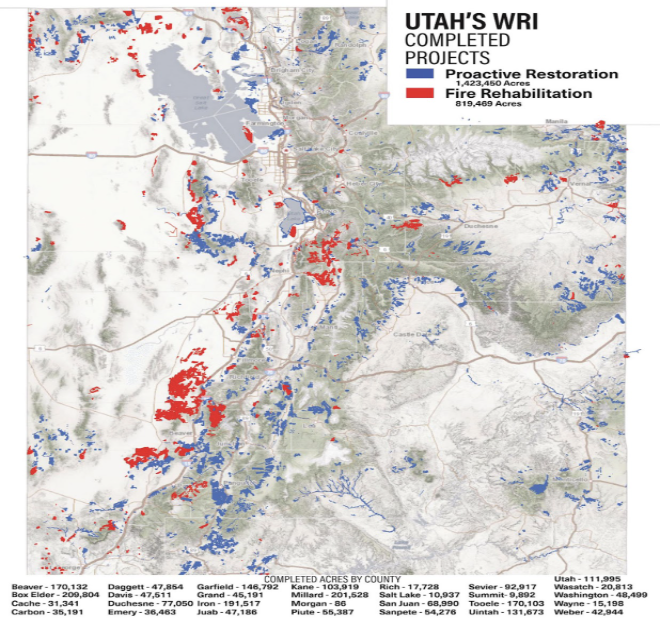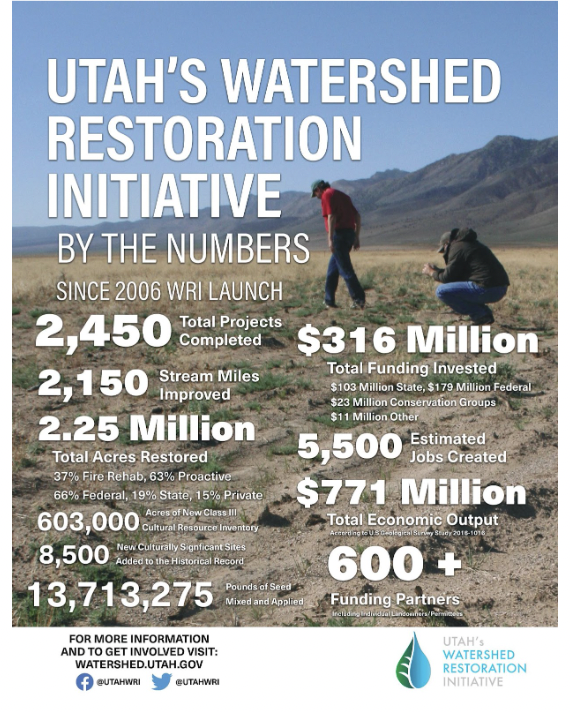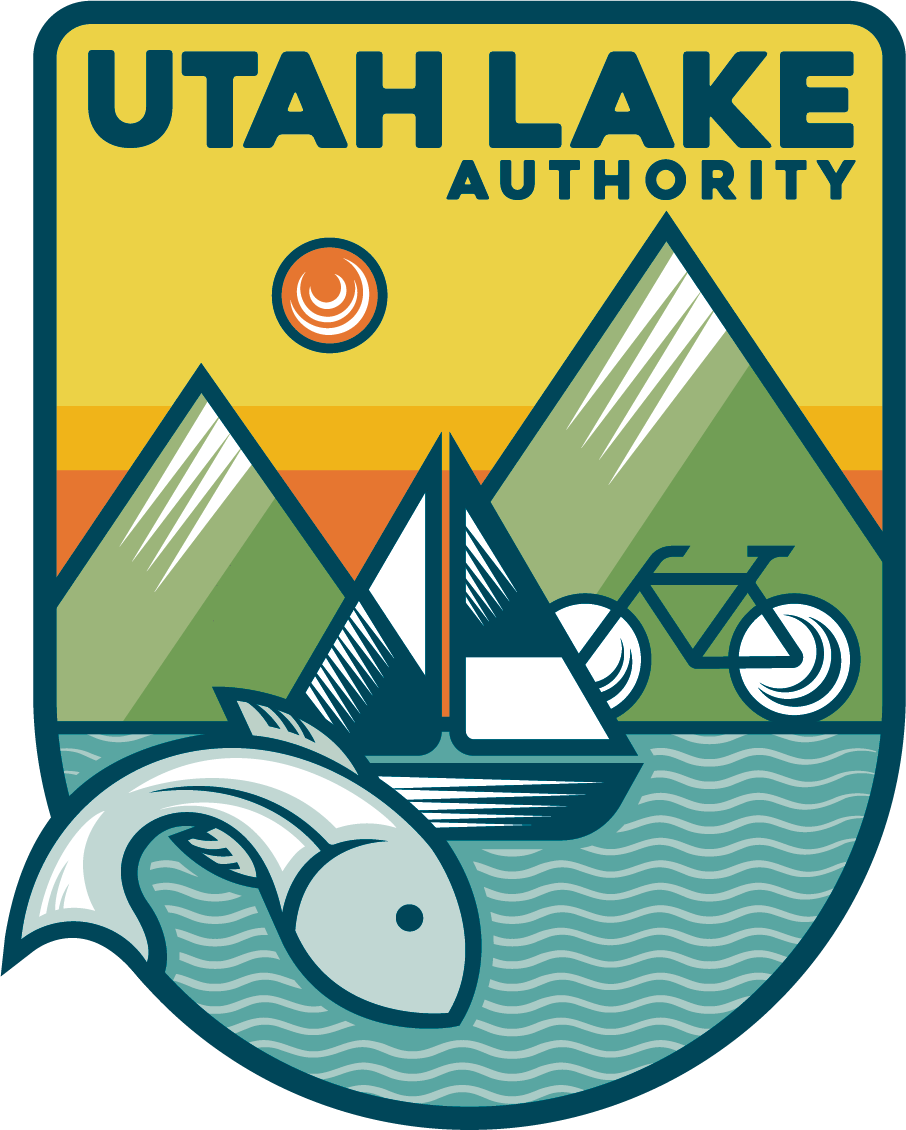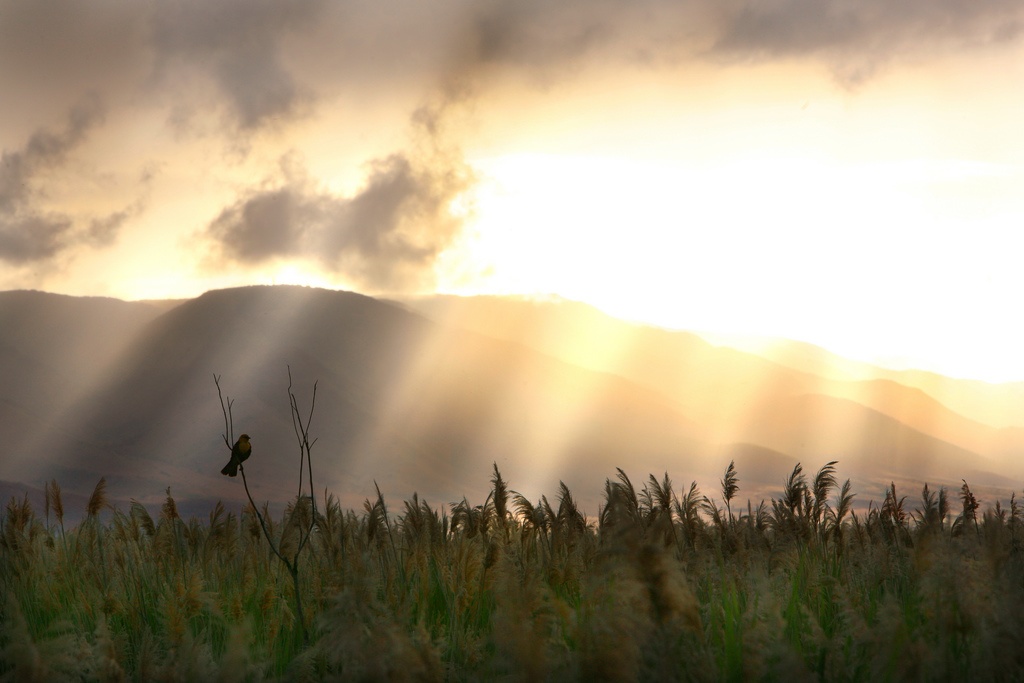Utah is a place with diverse landscapes, unique ecosystems, and natural resources. There are diverse recreational, agricultural, and economic opportunities. Healthy watersheds are the foundation for Utah. Watersheds sustain all that use them. Restoration projects maintain water quality and yield of watersheds while enhancing overall sustainability.
What is the Utah Wetland Restoration Initiative (WRI)?
Utah’s Watershed Restoration Initiative (WRI) is a partnership based program in Utah to improve high priority watersheds throughout the state. A watershed is the area in which the land drains into a specific watercourse or waterbody. Now in its 15th year, WRI focuses on improving three ecosystem values:
1) watershed health and biological diversity
2) water quality and yield
3) opportunities for sustainable uses of natural resources.
The WRI is a bottom-up initiative where project planning, review, and ranking occur at a local level. Five regional teams elect their own leaders, establish focus areas, review, score and rank project proposals using a comprehensive project prioritization score sheet, and assist their members in implementing projects.
The WRI is not just focused on one specific area or vegetation type, the WRI wants to work on all the areas across the watershed and is welcoming to all different kinds of projects. Some of the many challenges that WRI faces include reducing invasive plant species, limiting destructive fires, reversing aspen decline, and restoring degraded streams. The WRI rejuvenates damaged watersheds and promotes positive changes to reduce future problems. WRI projects also help restore natural processes to streams as well as surrounding riparian areas.

How the Initiative Works
There are many different types of habitat projects including projects completed for forest systems, rangelands, streams and riparian areas. One of WRI’s biggest goals is to diversify vegetation types, while keeping the land natural looking and mimicking what a natural disturbance would look like.
The program has permanent monitoring sites where they evaluate restoration of the vegetation. They go back to these sites every five years to check whether the vegetation is staying the same, getting better or getting worse as well as how it is being impacted. As they monitor the vegetation on each site they are able to create a trend of what is happening to the vegetation over time. The many different partnerships involved are crucial as there are different land management and funding that work together for this initiative.
We as people have a big impact on our ecosystems and make changes and alterations to them. We want these landscapes, clean air and clean water for future generations. Doing active management helps to mitigate or minimize some of the impacts that we artificially create.
What sets WRI apart from other similar programs is that they incentivize partnerships, they give additional points on the ranking sheets to projects that cross ownership boundaries and different vegetation types.
Accomplishments
“Since 2006, WRI partners have completed over 2,000 projects, improving over 1.6 million acres and nearly 1,200 miles of streams. Over 500 agencies, organizations and individuals have contributed to WRI projects by providing funding and in-kind assistance.”

How does the WRI program help Utah Lake?
Utah Lake Vegetation Restoration
The phragmites plant is an invasive species found on Utah Lake’s shoreline. And like many invasive species, the phragmites are particularly well adapted at overrunning native plant species and generally crowding out pristine shorelines. Phragmites present several risks to both the environment it invades and the human populations around them. These risks include lower lake levels, fire, loss of wildlife habitat, mosquitoes, loss of native plants, loss of accessible shoreline, and diminished views. As a result of these risks, the Utah Lake Commission, in partnership with Utah County and the Utah Division of Forestry, Fire and State lands, continual efforts to restore Utah Lake’s shoreline are underway.
Because phragmites is such an aggressively invasive species, it requires an equally aggressive treatment to restore Utah Lake shoreline. This is done through herbicidal treatment followed by giant crushers and mowers chopping up and stamping down the dead organic material for re-absorption into the ecosystem. You can learn more about the process of phragmites treatment on our blog.
Due to the tenacity of phragmites, there will be a certain percentage of regrowth in treated areas. However, this is why we plan to repeat the process over several years. In our test areas, we have found that this triple wash, rinse, repeat style has led to great results. A recent assessment done by Utah Division of Forestry, Fire and State Lands determined that the Utah Lake shoreline has seen a 70% decrease in the presence of phragmites.
History of WRI Support
The Utah Lake Commission has worked in partnership with the WRI for 12 years. All of the work being done and that has been done in the past is part of continual restoration and improvement efforts on Utah Lake. All of this is made possible by the collaborative efforts and funding power of Utah Division of Wildlife Resources (DWR), Forestry, Fire & State Lands (FFSL), and Utah County public works staff, as well as the DWR Wetland Restoration Initiative grant, and Utah Department of Agriculture’s Invasive Species Mitigation grant.
Future of WRI at Utah Lake
The work on removing phragmites, and other invasive vegetation will continue. Think of dandelions in your own lawn. If you don’t treat every year, those dandelions come back, sometimes in droves. Annual treatment will eventually move towards a “maintenance mode”; meaning, keeping the phragmites down to a minimal/manageable level in order to prevent a massive regrowth around the lake. Funding from WRI will continue to be crucial, as well as funding from the other partners at Utah Lake. WRI could also be a part of other watershed restoration projects at Utah Lake that are being considered, such as: planting trees along the shoreline, improving primitive access points along the lake and more.
The WRI grant program, the ISM grant program, Utah Division of Forestry, Fire and State Lands and Utah County are all valued partners in helping protect and improve the Utah Lake watershed. Conservation is a key element of the management of Utah Lake and provides much needed habitat for wildlife and accessibility for visitors to enjoy the lake.

